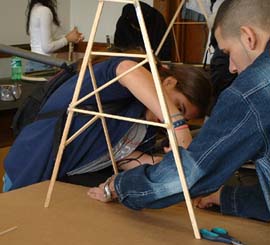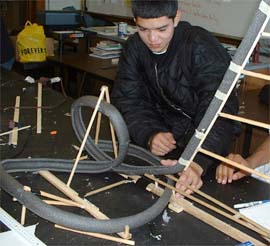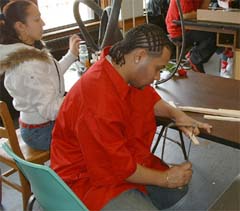|
|
|
“Education is not the filling of a pail, but the lighting of a fire.” — William Butler Yeats
At Central High School, most students take physics in the tenth grade instead of the eleventh or twelfth grade, as they do in many other schools. It can be an intimidating subject. This March, Central physics teacher Richard Gagnon gave his students an unusual assignment: to build a roller coaster. Students worked in teams, each coming up with their own design.
Richard Gagnon is one of Central's youngest and newest faculty members. He previously worked as a substitute in Providence, and before that taught for a year at a junior high school in Warwick.
When I first introduced the idea of a roller coaster project, the students were like, “Are we going to write about a roller coaster? Are we going to research a roller coaster?”
I said, “Yes, you're going to write about a roller coaster and, yes, you are going to research a roller coaster, but then you're also going to build a roller coaster.” And they were like, “Right, right, you're pulling our chains, we aren't going to really build a roller coaster?!”
Well, they did—and it was amazing. There wasn't a single student in the class who didn't participate or enjoy themselves or put their best into it. And the project fit right into the scope and sequence for physics.
At the end, I had students fill out a comment sheet to tell me what they thought about it. Some of the things they wrote amazed me, like the student who said, “It made me want to come to school every day.” A couple said, “Hey, I want to become an engineer now.”
I had a lot of kids who weren't doing well the first quarter, but after this project, their grades went up unbelievably, because there had been so much participation. A lot of them said, “I have a B average now? I want to keep that up the rest of the quarter!”
There are obstacles, to be sure, to doing this kind of hands-on project. First, it has to fit within the scope and sequence. Second, I spent a lot of my own money and time on the project—like cutting all the little pieces of wood they needed. Third, getting students into the mood of doing something different was hard. When I was setting up the groups, for example, you'd have one kid who didn't to work with another kid. But, then several students commented afterwards that one of the good things about the project was that they made new friends.
So the project didn't just bring on the learning of physics or a chance for students to believe in themselves—to accomplish something they thought they couldn't—but it also created a sense of community for the students.
For me, the project left me feeling 120 percent fulfilled. I felt I was doing my job the very best I could.
I told the students that a good ending to this unit would be to go to Six Flags Amusement Park and actually try these things out—like going on a roller coaster and having a penny in your hand and not having it fall out.
Photos of finished roller coasters and student comments >>
Central High School | 70 Fricker St., Providence, RI 02903 | 401.456.9111
Copyright © 2005 |




